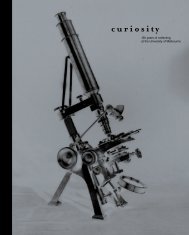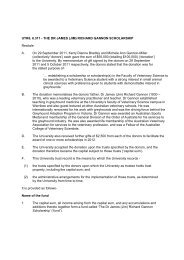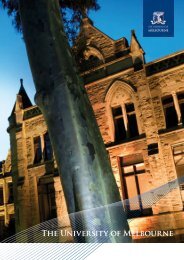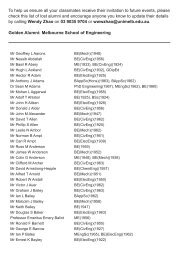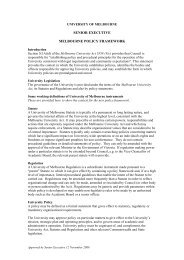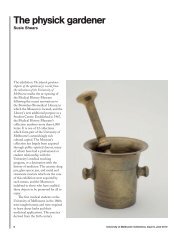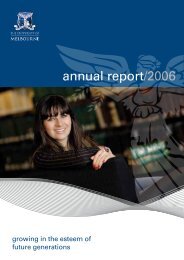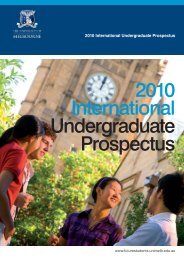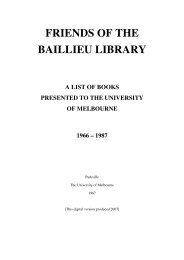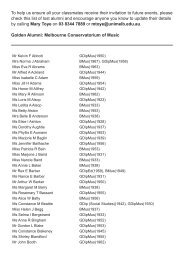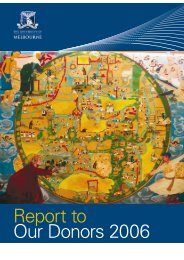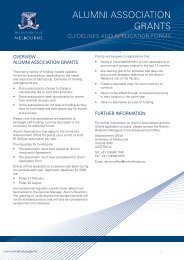2007 Annual report (PDF 8.1 Mb) - University of Melbourne
2007 Annual report (PDF 8.1 Mb) - University of Melbourne
2007 Annual report (PDF 8.1 Mb) - University of Melbourne
Create successful ePaper yourself
Turn your PDF publications into a flip-book with our unique Google optimized e-Paper software.
BINDING THE<br />
stRANDS TOGETHER<br />
<strong>Melbourne</strong> Model and Knowledge Transfer,<br />
or in responding strategically to the highly<br />
competitive landscape <strong>of</strong> research and in<br />
reforming administration has created new<br />
pressure points and issues.<br />
These changes have called for greater<br />
integration between planning and budgeting<br />
and have made it necessary for the<br />
<strong>University</strong> to look much further ahead.<br />
In response, the <strong>University</strong> released the<br />
<strong>University</strong> Plan early in the previous year to<br />
inform the detailed work <strong>of</strong> faculty business<br />
planning and other processes. <strong>2007</strong> saw<br />
an overhaul <strong>of</strong> the <strong>University</strong>’s planning<br />
processes and requirement for the first<br />
time for each budget division to produce<br />
a major business plan aligning strategy<br />
and funding over the next three years. The<br />
<strong>University</strong> has instituted annual business<br />
planning in all divisions as a means <strong>of</strong><br />
addressing strategic and more operational<br />
issues. Planning and forecasting tools have<br />
been developed to support faculties in this<br />
process, and significant progress has been<br />
made in building a <strong>University</strong> management<br />
information system which can provide a<br />
timely and consistent set <strong>of</strong> data on which<br />
planning and budgeting can proceed.<br />
The revised framework has been rolled<br />
out, to ensure stronger sequencing and<br />
linkage between <strong>University</strong> and divisional<br />
levels, and between planning, budgeting,<br />
risk management, quality assurance and<br />
<strong>report</strong>ing. Full implementation will occur<br />
over 2008-2009.<br />
Risk<br />
Strategic Priority<br />
> Improve management <strong>of</strong> risk, including<br />
compliance with the new ACRCR,<br />
revised SafetyMap, EHS and ESOS Act<br />
obligations and Crisis Management and<br />
Business Continuity Planning.<br />
Achievements<br />
A Strategic Risk Framework and<br />
Program, focussing on identification,<br />
rating, mitigation and <strong>report</strong>ing has been<br />
established. The Program embeds risk<br />
management in business planning and<br />
review. The Risk Management Committee<br />
was re-constituted in December <strong>2007</strong> in<br />
order to provide greater strategic focus on<br />
risk management.<br />
A Crisis Management Plan, designed<br />
to establish a framework for business<br />
operations continuity during a sustained<br />
emergency, was developed in <strong>2007</strong>,<br />
complementing the Emergency<br />
Management Plan. The Emergency<br />
Management Plan was tested when a gas<br />
leak forced the successful evacuation <strong>of</strong> a<br />
quarter <strong>of</strong> the Parkville campus. An exercise<br />
testing the Crisis Management Plan while<br />
overall successful, highlighted need for<br />
modification <strong>of</strong> the Plan and further training.<br />
Service Agreements<br />
Strategic Priority<br />
> Expand service agreements to all faculties<br />
Achievements<br />
Development <strong>of</strong> templates for service<br />
agreements was postponed pending<br />
completion <strong>of</strong> various change programs<br />
underway including planning for the new<br />
student services model. The framework<br />
may be incorporated into the <strong>University</strong>’s<br />
administrative business plan at a later date<br />
to describe how the <strong>University</strong> conducts<br />
its support services for students, staff and<br />
external stakeholders.<br />
Challenges for 2008 will be to improve<br />
management <strong>report</strong>ing, quality assurance<br />
around introduction <strong>of</strong> the <strong>Melbourne</strong><br />
Model, deliver the first significant<br />
functionality from the <strong>University</strong> MIS and to<br />
more tightly integrate the business planning<br />
process as between faculties, <strong>University</strong><br />
Services the new Office <strong>of</strong> the Provost.<br />
Outlook<br />
The focus in 2008 will continue to<br />
be rationalisation <strong>of</strong> the provision <strong>of</strong><br />
information services, cost containment,<br />
the reshaping <strong>of</strong> the service delivery model<br />
for administrative services in general and<br />
finance and human resources in particular<br />
and the development <strong>of</strong> a revised planning<br />
and budget framework as part <strong>of</strong> a major<br />
overhaul <strong>of</strong> the <strong>University</strong>’s governance and<br />
management processes and structures.<br />
PROFILE<br />
Pr<strong>of</strong>essor<br />
KEN Hinchcliff<br />
The newly appointed Dean <strong>of</strong> the<br />
Faculty <strong>of</strong> Veterinary Science, Pr<strong>of</strong>essor<br />
Ken Hinchcliff, is internationally<br />
recognised as a scholar <strong>of</strong> veterinary<br />
internal medicine and exercise<br />
physiology. In <strong>2007</strong> he was presented<br />
with the Charles Capen Award for<br />
excellence in graduate education from<br />
the College <strong>of</strong> Veterinary Medicine at<br />
the Ohio State <strong>University</strong>.<br />
He has been a driving force in research<br />
on exercise-related conditions with<br />
horses, which has provided critical<br />
information for policy-makers in the<br />
horse racing industry throughout the<br />
world. It has also been beneficial in<br />
helping veterinarians and horsemen to<br />
make prudent and informed decisions.<br />
Pr<strong>of</strong>essor Hinchcliff has an extensive<br />
publication record including over 150<br />
scientific publications in pr<strong>of</strong>essional<br />
journals. He is also the co-editor <strong>of</strong><br />
the recently published book Equine<br />
Exercise Physiology: The Science <strong>of</strong><br />
Exercise in the Athletic Horse and <strong>of</strong><br />
one <strong>of</strong> the world’s leading veterinary<br />
publications – the Journal <strong>of</strong> Veterinary<br />
Internal Medicine.<br />
The <strong>University</strong> <strong>of</strong> <strong>Melbourne</strong> <strong>Annual</strong> Report <strong>2007</strong> 69



